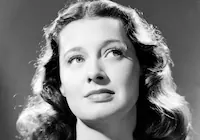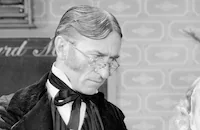Crime Doctor's Man Hunt
Brief Synopsis
Cast & Crew
William Castle
Warner Baxter
Ellen Drew
William Frawley
Frank Sully
Claire Carleton
Film Details
Technical Specs

Synopsis
At his office, detective psychiatrist Dr. Robert Ordway meets with a war veteran who is suffering from bomb shock and combat fatigue, and who has an inexplicable fascination with a particularly tough neighborhood in the city. Later that evening, when Ordway visits the neighborhood to search for clues to his patient's behavior, he happens upon a murder scene, and immediately realizes that his patient is the victim. When two men escape with the dead body, Ordway summons police inspector Harry B. Manning to the scene. Manning begins an investigation into the murder by questioning the landlady of the building from which the two men were seen fleeing. The police also search other rooms in the apartment building, but they find no clues. Recalling his brief meeting with the murder victim, Ordwawy remembers that his patient had mentioned an astrologer named Alfredi, who predicted that he would meet a violent death. While Ordway tries to find Alfredi, the two men seen carrying the dead body out of the apartment building pay a visit to a mysterious blonde woman. The woman, who hired the two men to dispose of the body, refuses their demand for more money and sends them away. As the police investigation continues without the discovery of a single clue, Manning begins to doubt Ordway's assertion that a murder actually took place. Ordway, however, is determined to find the killer, and continues his investigation by acquainting himself with Ruby Farrell, who lives in the apartment building where the man was murdered and who runs a shooting gallery concession at a carnival. Ruby takes Ordway to an abandoned house next to her apartment building, and when Ordway enters the house alone, he is knocked unconscious by the two men working for the blonde woman. The next day, the police find the dead body and the victim is identified as Philip Armstrong. When it is determined that Armstrong was killed by a type of air pistol used at carnivals, Manning arrests Ruby on suspicion of murder. Ordway, however, does not believe that Ruby is the killer, and decides to track down the owner of the abandoned house, Gerald Cotter, who happens to be the father of Philip's fiancée Irene. Gerald insists that the house has been abandoned for years, and provides Ordway with no further clues. A short time later, when the killer's two accomplices are discovered murdered in an apartment, Ordway finds an address book at the scene containing Alfredi's address. Alfredi is then brought to the police for questioning, and he confesses that a woman named Natalie hired him to put a scare in her sister's fiancé. Natalie, it is soon learned, is Irene's estranged sister, and died six weeks earlier, so she could not have been involved in any of the murders. Hoping to catch the killer in action, Ordway sets a trap at the abandoned house. His plan succeeds when Irene, disguised in a blonde wig that makes her resemble her dead sister, emerges from a darkened corner with her gun drawn. When Manning bursts into the room, Ordway disarms Irene and exposes her as the killer. Ordway then pieces together the mystery and explains to Manning that Irene suffers from a mental condition stemming from the death of her sister, and that she so strongly relied upon her sister's strength that she occasionally assumed her identity. He also explains that Irene decided to kill Philip when Philip discovered her split personality.

Director

William Castle
Cast

Warner Baxter

Ellen Drew

William Frawley
Frank Sully
Claire Carleton
Bernard Nedell
Jack Lee
Francis Pierlot
Myron Healy

Olin Howlin
Ivan Triesault
Paul E. Burns
Mary Newton
Leon Lenoir
Robert Dehaven
Frank Cody
Minerva Urecal
Harry Hayes Morgan
Cy Malis
Wanda Perry
Joseph Palma
Ralph Linn
John Manning
Ernest Hilliard
Stella Lesaint
Crew
Mischa Bakaleinikoff
Leigh Brackett
Dwight Caldwell
Lambert Day
Philip Faulkner
Rudolph C. Flothow
James M. Goss
Carl Hiecke
William Montague
Hans Radon
Philip Tannura
Eric Taylor

Film Details
Technical Specs

Articles
Ellen Drew, 1914-2003
She was born Esther Loretta "Terry" Ray on November 23, 1914, in Kansas City, Missouri. The daughter of a barber, her family moved to Chicago when she was still an infant and she lived a very quiet childhood far removed from the glamour of Hollywood. She was encouraged by some friends to enter a beauty contest when she was just 17. After winning, she tried her luck in Hollywood, but found that they were no immediate offers for her particular talents.
She eventually took a waitressing job at C.C. Brown's, a famed Hollywood Boulevard soda fountain, and had virtually abandoned her dreams as a starlet when William Demarest, a popular actor's agent and well-known character actor, spotted her. Demarest arranged a screen test for her at Paramount, and she was promptly placed under contract for $50 a week.
For the first few years, (1936-38), Drew got only bit parts, and was often uncredited. When she finally got prominent billing in the Bing Crosby musical Sing You Sinners (1938), she decided to change her name, from Terry Ray to Ellen Drew. She earned her first major role in Frank Lloyd's If I Were King (1938) opposite Ronald Colman, yet for the most part of her career, rarely rose above "B" material and second leads. Still, she had some fine exceptions: Preston Sturges' enchanting comedy Christmas in July (1940), with Dick Powell; Tay Garnett's lighthearted war romp My Favorite Spy (1942) co-starring Kay Kyser; Julien Duvivier's taut The Imposter (1944), holding her own with a brooding Jean Gabin; and Mark Robson's chilling low-budget chiller Isle of the Dead (1945) opposite Boris Karloff. Drew made some notable television appearances in the late '50s including Perry Mason and The Barbara Stanwyck Show, before retiring from the entertainment industry. She is survived by her son David; five grandchildren; and five great-grandchildren.
by Michael T. Toole

Ellen Drew, 1914-2003
Quotes
Say, Doctor, I'd like you to see my wife.- Police Inspector Harry B. Manning
Split personality?- Dr. Robert Ordway
No personality.- Police Inspector Harry B. Manning
Trivia
Notes
The working title of this film was The Crime Doctor's Honor. For additional information on the "Crime Doctor" series, please consult the Series Index and see the entry above for Crime Doctor.














